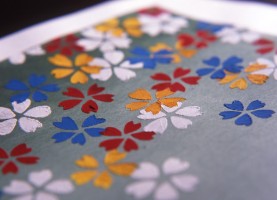

版画の技法は奈良時代(8 世紀)に中国から伝わり、摺仏、摺 経 など仏教の広がりとともに発展しました。その後京都の版画は、出版文化と強く結びついていきます。特に江戸時代(17~19 世紀)は仮名草子、浮世草子の挿絵に版画絵師が活躍し、江戸にも名をとどろかせました。井原西鶴の「絵本好 色 一代 男 」の挿絵は、京都の版画絵師、吉田半兵衛の作です。また扇面や団扇、さらに明治以降は日本画の木版本としても 京 版画の技術は高く評価されました。 京 都画派の木版本はその代表的なもので、海外にも紹介されています。
The art of woodblock printing was introduce to Japan in the 8th century during the Nara Period, and developed with the spread of Buddhism as an efficient means of reproducing Buddhist imagery and scrolls. Woodblock printing has since been closely associated with publishing in Kyoto. During the Edo Period(17th-19th centuries), Kyoto woodblock printers produced vernacular picture books read even in the Edo capital. The Kyoto printer Yoshida Hanbei produced the illustrations for The Life of an Amorous Man, an important early work by Ihara Saikaku. Kyoto woodblock prints were also used on fans and in Japanese woodblock print books from the Meiji Period. Woodblock print books from Kyoto are typical of this genre, and are widely known abroad.
手摺り木版画を現代アートとして生活の中に
伝統と現代との出合い
The incorporation of manual woodblock printing into life as modern art Tradition meets modernity.



